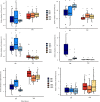Species and individual rhinoceros affect the bacterial communities, metabolites, and nutrient composition in faeces from Southern black rhinoceros (Diceros bicornis minor) and Southern white rhinoceros (Ceratotherium simum simum) under managed care
- PMID: 33655648
- PMCID: PMC9292196
- DOI: 10.1111/jpn.13520
Species and individual rhinoceros affect the bacterial communities, metabolites, and nutrient composition in faeces from Southern black rhinoceros (Diceros bicornis minor) and Southern white rhinoceros (Ceratotherium simum simum) under managed care
Abstract
Gut microbiota are essential to nutrient metabolism and the maintenance of hindgut health. The characterization of faecal bacterial communities from healthy individuals is important for the establishment of baseline data that can be compared to periods of gut dysbiosis. Diet is a key determinant of the faecal microbial community structure and generation of volatile fatty acids, a main energy source for the host. While rhinoceroses are herbivores, black rhinoceroses are browsers and white rhinoceroses are grazers. The objective of our study was to characterize and compare diets, faecal bacterial communities, nutrients and metabolites between and amongst Southern white rhinoceroses and Southern black rhinoceroses (n = 3 rhinos/species) managed at Disney's Animal Kingdom® . Faecal bacterial communities were similar between individual white rhinos and dissimilar between species and individual black rhinos. Faecal butyrate and propionate molar proportions and concentrations were greater in black rhinos than white rhinos, whereas lactate was greater in white rhinos. The Shannon diversity, total operational taxonomic units, and relative abundance of Firmicutes were greater in white than black rhinos. The relative abundance of Proteobacteria in faeces from black rhinos was 3-fold greater than from white rhinos. One black rhino had a greater relative abundance of Verrucomicrobia (7.45 ± 1.31%) than all other individual rhinos (0.01-1.37%). White rhinoceroses demonstrated similar abundances of bacterial phyla and communities between one another and by individual, while black rhinoceroses were more dissimilar by individual. The dissimilarities between black rhinos were suspected to be due to total diet consumption variability, including browse diversity, and lack of direct contact. In contrast, the white rhinos commingled (i.e. nose-to-nose contact) and consumed similar amounts of hay, pellets and training items. These results suggest that species-specific diets and the individual contribute to differences in faecal bacterial communities, nutrients and metabolites between black and white rhinos housed at the same institution.
Keywords: VFA; diversity; inter-animal; microbiota; rhinoceroses; rhinos.
© 2021 The Walt Disney Company. Journal of Animal Physiology and Animal Nutrition published by Wiley-VCH GmbH.
Conflict of interest statement
The authors declare no conflict of interest.
Figures




Similar articles
-
Comparative investigations on digestion in grazing (Ceratotherium simum) and browsing (Diceros bicornis) rhinoceroses.Comp Biochem Physiol A Mol Integr Physiol. 2010 Aug;156(4):380-8. doi: 10.1016/j.cbpa.2010.03.006. Epub 2010 Mar 12. Comp Biochem Physiol A Mol Integr Physiol. 2010. PMID: 20227512 Clinical Trial.
-
Digestion coefficients achieved by the black rhinoceros (Diceros bicornis), a large browsing hindgut fermenter.J Anim Physiol Anim Nutr (Berl). 2006 Aug;90(7-8):325-34. doi: 10.1111/j.1439-0396.2006.00606.x. J Anim Physiol Anim Nutr (Berl). 2006. PMID: 16867078
-
Parasites of domestic and wild animals in South Africa. XLIX. Ticks (Acari: Ixodidae) infesting white and black rhinoceroses in southern Africa.Onderstepoort J Vet Res. 2017 Jan 30;84(1):e1-e11. doi: 10.4102/ojvr.v84i1.1301. Onderstepoort J Vet Res. 2017. PMID: 28155285 Free PMC article.
-
Comparative analysis of gestation in three rhinoceros species (Diceros bicornis; Ceratotherium simum; Rhinoceros unicornis).Gen Comp Endocrinol. 2023 Apr 1;334:114214. doi: 10.1016/j.ygcen.2023.114214. Epub 2023 Jan 13. Gen Comp Endocrinol. 2023. PMID: 36646327 Review.
-
Review of laboratory and necropsy evidence for iron storage disease acquired by browser rhinoceroses.J Zoo Wildl Med. 2012 Sep;43(3 Suppl):S92-104. doi: 10.1638/2011-0177.1. J Zoo Wildl Med. 2012. PMID: 23156711 Review.
Cited by
-
Novel gut bacteria species Paenibacillus ilasis with phosphorus degrading and soluble starch hydrolysis abilities isolated from fresh feces of rhinoceros.Sci Rep. 2025 Jul 1;15(1):21750. doi: 10.1038/s41598-025-06760-w. Sci Rep. 2025. PMID: 40596264 Free PMC article.
-
Capture and transport of white rhinoceroses (Ceratotherium simum) cause shifts in their fecal microbiota composition towards dysbiosis.Conserv Physiol. 2023 Nov 24;11(1):coad089. doi: 10.1093/conphys/coad089. eCollection 2023. Conserv Physiol. 2023. PMID: 38026796 Free PMC article.
-
Rhinoceromics: a multi-amplicon study with clinical markers to transferrin saturation levels in ex-situ black rhinoceros (Diceros bicornis michaeli).Front Microbiol. 2025 May 29;16:1515939. doi: 10.3389/fmicb.2025.1515939. eCollection 2025. Front Microbiol. 2025. PMID: 40510676 Free PMC article.
-
Effects of age, seasonality, and reproductive status on the gut microbiome of Southern White Rhinoceros (Ceratotherium simum simum) at the North Carolina zoo.Anim Microbiome. 2023 May 5;5(1):27. doi: 10.1186/s42523-023-00249-5. Anim Microbiome. 2023. PMID: 37147724 Free PMC article.
References
-
- Bergmann, G. T. , Bates, S. T. , Eilers, K. G. , Lauber, C. L. , Caporaso, J. G. , Walters, W. A. , Knight, R. , & Fierer, N. (2011). The under‐recognized dominance of Verrucomicrobia in soil bacterial communities. Soil Biology and Biochemistry, 43, 1450–1455. 10.1016/j.soilbio.2011.03.012 - DOI - PMC - PubMed
-
- Biddle, A. , Stewart, L. , Blanchard, J. , & Leschine, S. (2013). Untangling the genetic basis of fibrolytic specialization by lachnospiraceae and ruminococcaceae in diverse gut communities. Diversity, 5, 627–640. 10.3390/d5030627 - DOI
MeSH terms
LinkOut - more resources
Full Text Sources
Other Literature Sources

